In flight
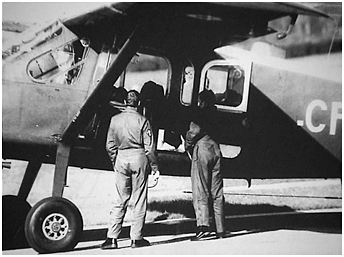 Derniers préparatifs avant de partir en mission au-dessus de la BCZ avec un Broussard. © MMFL.
Derniers préparatifs avant de partir en mission au-dessus de la BCZ avec un Broussard. © MMFL.
Final preparations before leaving on a mission over the BCZ with a Broussard. © FMLM.
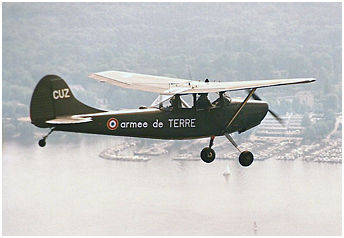 Lieutenant Colonel (Air) Augoyard and Major (Army) Pietrini, invite us to accompany them on one of the many air reconnaissance missions that FMLM crews flew.
February 1982, 11H30; the Broussard is waiting on the tarmac at Berlin-Tegel. The weather is good and promises to be relatively stable - two miles of horizontal
visibility - which means a few patches of fog and pollution over the GDR and especially over Brandenburg and to the west of Potsdam. This afternoon, Major Pietrini
will be on the "Local" and the "Air Recce" is therefore an exceptional way to prepare for this particular mission. It is a routine flight over the different
garrisons for observation of various equipment in motor pools, especially those of the 34th Artillery Division, the 35th Guards Motorized Rifle Division and the
20th Armored Division. The choice of targets is so large that it is a bit like going "to the market" of tactical and technical intelligence gathering.
Lieutenant Colonel (Air) Augoyard and Major (Army) Pietrini, invite us to accompany them on one of the many air reconnaissance missions that FMLM crews flew.
February 1982, 11H30; the Broussard is waiting on the tarmac at Berlin-Tegel. The weather is good and promises to be relatively stable - two miles of horizontal
visibility - which means a few patches of fog and pollution over the GDR and especially over Brandenburg and to the west of Potsdam. This afternoon, Major Pietrini
will be on the "Local" and the "Air Recce" is therefore an exceptional way to prepare for this particular mission. It is a routine flight over the different
garrisons for observation of various equipment in motor pools, especially those of the 34th Artillery Division, the 35th Guards Motorized Rifle Division and the
20th Armored Division. The choice of targets is so large that it is a bit like going "to the market" of tactical and technical intelligence gathering.
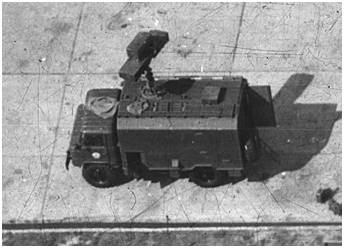
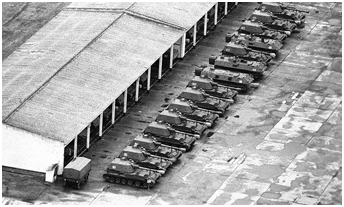 For the two years they have flown the missions together, the pilot and the observer appreciate these observations, the cooperation that they require and the
privileged relationship that unites both of them. Take off safely between BEA, Air France or Pan Am civilian traffic, overfly at 100 meters above the Borsig factory and
cap correction over Foch city and the commissaries, Tegel again, and some moments later, the Berlin Wall. Immediately, the usual vision of East Germany: a
patchwork of fields, lakes, forests, towns and villages uniformly gray-colored, with red tile roofs often obscured by the black smoke of the factories. Soon
they take a north-northwesterly heading toward Reinickendorf and then Hennigsdorf. They then make a pass over targets at the East German 1st Motorized Rifle
Division at Oranienburg, near the remnants of the concentration camp close to the BCZ limits. Further south, Schönwalde and its garrison appear on the horizon.
It has already been a long time now that the observers have managed to orient themselves without a map and it seems that, even today, many of them could return
and with no difficulty locate the approach axes, the target denominations, their number, the location of tank parks, hangars and deployment areas.
For the two years they have flown the missions together, the pilot and the observer appreciate these observations, the cooperation that they require and the
privileged relationship that unites both of them. Take off safely between BEA, Air France or Pan Am civilian traffic, overfly at 100 meters above the Borsig factory and
cap correction over Foch city and the commissaries, Tegel again, and some moments later, the Berlin Wall. Immediately, the usual vision of East Germany: a
patchwork of fields, lakes, forests, towns and villages uniformly gray-colored, with red tile roofs often obscured by the black smoke of the factories. Soon
they take a north-northwesterly heading toward Reinickendorf and then Hennigsdorf. They then make a pass over targets at the East German 1st Motorized Rifle
Division at Oranienburg, near the remnants of the concentration camp close to the BCZ limits. Further south, Schönwalde and its garrison appear on the horizon.
It has already been a long time now that the observers have managed to orient themselves without a map and it seems that, even today, many of them could return
and with no difficulty locate the approach axes, the target denominations, their number, the location of tank parks, hangars and deployment areas.
Teamwork
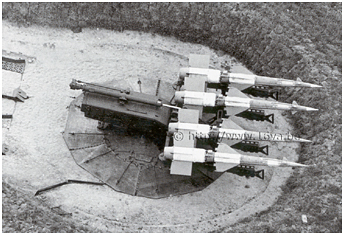
 Such confirmed observers had the privilege of recognizing an interesting detail in a fraction of a second at an altitude of 100 meters. Essentially,
this was the result of several years of work and experience. It was out of the question to make two successive pass over the same target or a flare could
be fired at you. It is, however, the risk that Major Pietrini had taken a few days earlier, on January 22, 1982. As they passed over Schönwalde, something
caught his attention; however, he could not really define what it was. Trusting the judgment of the observer, the pilot had agreed to do a second pass and
the major took a new series of photos. It was then that he noticed in the viewfinder that a white letter "K" had been applied to the roof of each and every
vehicle, wheeled and armored. Back at the FMLM facilities, he carefully examined the pictures taken that confirmed his observation. These identification letters
that were invisible from the ground were probably intended to distinguish friends from enemies from the third dimension on the battlefield. During their
interventions in Hungary and Czechoslovakia, the Soviets had painted white stripes on their vehicles and red bands on their aircraft in order to distinguish
them clearly. So, were forthcoming maneuvers pending or were these preparations for an invasion?
Such confirmed observers had the privilege of recognizing an interesting detail in a fraction of a second at an altitude of 100 meters. Essentially,
this was the result of several years of work and experience. It was out of the question to make two successive pass over the same target or a flare could
be fired at you. It is, however, the risk that Major Pietrini had taken a few days earlier, on January 22, 1982. As they passed over Schönwalde, something
caught his attention; however, he could not really define what it was. Trusting the judgment of the observer, the pilot had agreed to do a second pass and
the major took a new series of photos. It was then that he noticed in the viewfinder that a white letter "K" had been applied to the roof of each and every
vehicle, wheeled and armored. Back at the FMLM facilities, he carefully examined the pictures taken that confirmed his observation. These identification letters
that were invisible from the ground were probably intended to distinguish friends from enemies from the third dimension on the battlefield. During their
interventions in Hungary and Czechoslovakia, the Soviets had painted white stripes on their vehicles and red bands on their aircraft in order to distinguish
them clearly. So, were forthcoming maneuvers pending or were these preparations for an invasion?
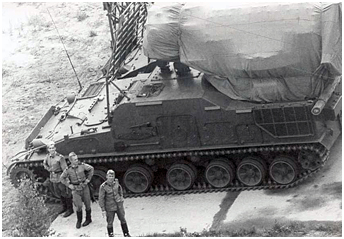
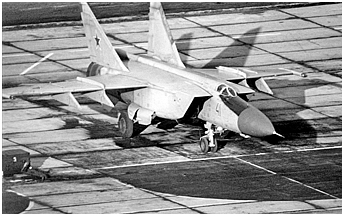 In January 1982, turmoil had not ceased in Poland. As a member of the Warsaw Pact, the Polish Army had many wheeled and armored vehicles of Soviet manufacture.
The special markings could therefore have been applied to identify the equipment and avoid fratricidal firings, should an intervention occur.
The aerial reconnaissance mission was a real teamwork effort and it was prepared in an atmosphere of complete mutual trust. Today's crew, pilot and observer,
get along famously together and, as far as the observer is concerned, he equally enjoys flying aboard the Air Force Broussard as he does in the L-19
with his comrades from the Army. His pilot for today is the "Air" operations chief who asks him to take additional pictures of some "Air Priority" targets,
including Oranienburg and Werneuchen airfields from where a "Brewer" takes off from time to time to cross their path. They are used to flying together and, under
these conditions, the observer can focus on his own work. With an experienced fighter and reconnaissance pilot at the controls, there was no real concern about
navigation. That was not necessarily the case when a neophyte flew that kind of mission. One did not improvise during a flight over East Germany. The requirement
was the same for ground reconnaissance tours: several years of experience were necessary for an NCO to truly master his observer and "Local" crew chief tasks.
He had to be able to "feel" a possible unit move or to capture the opportunity to bring back a picture of a "bâché NI" (covered, unidentified) that would be
identified either immediately thanks to each crew member's experience or when the films were processed.
In January 1982, turmoil had not ceased in Poland. As a member of the Warsaw Pact, the Polish Army had many wheeled and armored vehicles of Soviet manufacture.
The special markings could therefore have been applied to identify the equipment and avoid fratricidal firings, should an intervention occur.
The aerial reconnaissance mission was a real teamwork effort and it was prepared in an atmosphere of complete mutual trust. Today's crew, pilot and observer,
get along famously together and, as far as the observer is concerned, he equally enjoys flying aboard the Air Force Broussard as he does in the L-19
with his comrades from the Army. His pilot for today is the "Air" operations chief who asks him to take additional pictures of some "Air Priority" targets,
including Oranienburg and Werneuchen airfields from where a "Brewer" takes off from time to time to cross their path. They are used to flying together and, under
these conditions, the observer can focus on his own work. With an experienced fighter and reconnaissance pilot at the controls, there was no real concern about
navigation. That was not necessarily the case when a neophyte flew that kind of mission. One did not improvise during a flight over East Germany. The requirement
was the same for ground reconnaissance tours: several years of experience were necessary for an NCO to truly master his observer and "Local" crew chief tasks.
He had to be able to "feel" a possible unit move or to capture the opportunity to bring back a picture of a "bâché NI" (covered, unidentified) that would be
identified either immediately thanks to each crew member's experience or when the films were processed.
The text on this page is excerpted and adapted from the book "Propusk" by Patrick Manificat published by Lavauzelle Editions.
See > Multimedia
Until 1994...
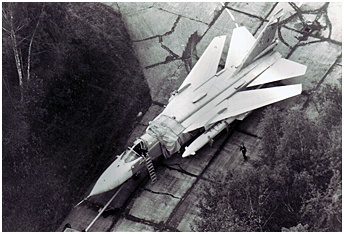
 The situation for the FMLM changed after November 9, 1989. The late Daniel Trastour of the FMLM wrote the following in his book entitled "The war without weapons:"
« The FMLM continued to exist. However, its working methods had changed in light of the new circumstances: in order to avoid upsetting our new
Russian friends and cause a stir, Paris forbade any ground missions! By the way, the other allied missions were authorized by their governments to continue their ground missions!
On the other hand, the Russians authorized flights over the former GDR provided that strict air routes were followed. I regularly received reports from the FMLM
[Daniel Trastour was then assigned to the Advanced Intelligence Center (CRA) of Baden-Oos, i.e. the very center that dealt with the FMLM products]
and as I had the flight grid imposed by the Russians, I realized quickly that some flights sometimes suffered from a serious crosswind that pushed them towards
a major target located inside a PRA, that usually we could not observe! We received no complaints from the Soviets, as they were focused on repatriating
their equipment to Russia! »
The situation for the FMLM changed after November 9, 1989. The late Daniel Trastour of the FMLM wrote the following in his book entitled "The war without weapons:"
« The FMLM continued to exist. However, its working methods had changed in light of the new circumstances: in order to avoid upsetting our new
Russian friends and cause a stir, Paris forbade any ground missions! By the way, the other allied missions were authorized by their governments to continue their ground missions!
On the other hand, the Russians authorized flights over the former GDR provided that strict air routes were followed. I regularly received reports from the FMLM
[Daniel Trastour was then assigned to the Advanced Intelligence Center (CRA) of Baden-Oos, i.e. the very center that dealt with the FMLM products]
and as I had the flight grid imposed by the Russians, I realized quickly that some flights sometimes suffered from a serious crosswind that pushed them towards
a major target located inside a PRA, that usually we could not observe! We received no complaints from the Soviets, as they were focused on repatriating
their equipment to Russia! »
Although the French Military Liaison Mission was disbanded on June 30, 1991, some of its personnel were reassigned to the intelligence service
(2è Bureau) of the French HQ in Berlin (1) to continue their intelligence work (the
FMLM photo laboratory was not closed until August 1994 and the archives were stupidly destroyed).
In order to appear less conspicuous or at least less provocative, the "armée de TERRE" markings painted on the French Army Detachment (DETALAT)
L-19 fuselages and Alouette III tail booms were removed. As mentioned above, the rules for air traffic above the former
GDR were reviewed. The Allied aircraft could now fly through the BCZ and the outer edges of corridors A (north) and C (south) encompassing all the territory
between them. The helicopter flights that were limited to the West Berlin area prior to this time, were authorized throughout the whole area. However,
the new official limits seemed much harder for the Allied pilots to respect; they seemed to make quite a lot of "navigational errors" and overflew off-limits
military installations!
For example, those of us who were present at Wittstock on April 7, 1994 to witness the departure of the last MiG-29 of the 33.IAP for Damgarten perhaps will
remember the French Alouette III that flew over the airbase early that morning.
However, the Russians did not seem to complain but it is true that the die was cast. How were the new limits set?
By the range of the aircraft or helicopter: they were not allowed to land on a former East-German base to refuel. HM.
The DETALAT Berlin after the fall of the Berlin Wall > LINK
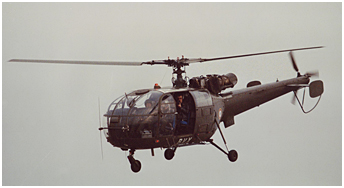 |
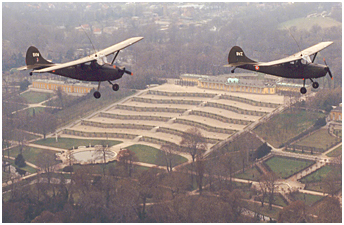 |
notes
(1) During the Cold War, the 2è Bureau was the agency responsible for intelligence gathering in East-Berlin.
 |
The "Air Recce" of the FMLM < Part 1 |
 |
Plan du site - Sitemap |  |
